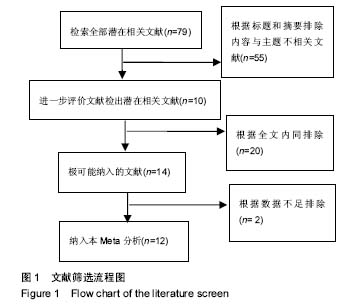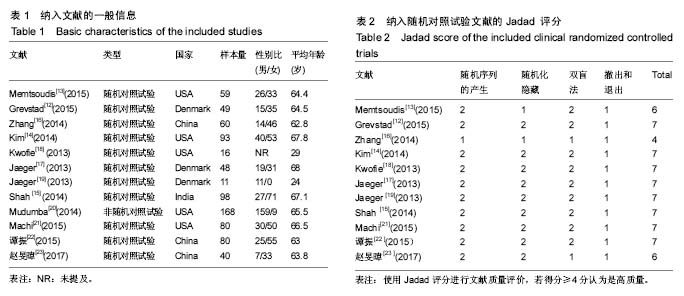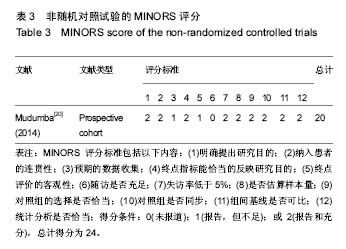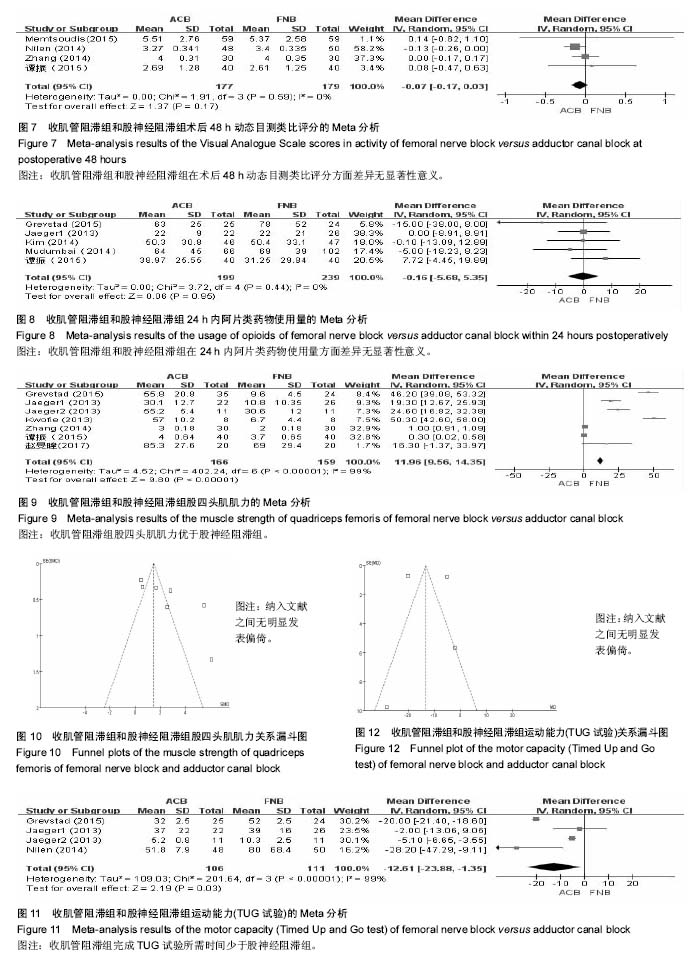| [1] Merle-Vincent F, Couris CM, Schott AM, et al. Factors predicting patient satisfaction 2 years after total knee arthroplasty for osteoarthritis. Joint Bone Spine. 2011;78(4): 383-386.[2] Skinner HB, Shintani EY. Results of a multimodal analgesic trial involving patients with total hip or total knee arthroplasty.Am J Orthop. 2004;33(2):85-92.[3] Chan EY, Fransen M, Sathappan S, et al. Comparing the analgesia effects of single-injection and continuous femoral nerve blocks with patient controlled analgesia after total knee arthroplasty. J Arthroplasty. 2013;28(4):608-613.[4] Brian M, Jonathan J, Douglas W, et al. ong-Term Pain,Stiffness, and Functional Disability Following Total Knee Arthroplasty With and Without an Extended Ambulatory Continuous Femoral Nerve Block: A Prospective, One-Year Follow-Up of a Multicenter, Randomized, Triple-Masked, Placebo-Controlled Trial. Reg Anesth Pain Med. 2011;36(2):116-120.[5] 彭周全,张卫,李丽伟.股神经阻滞对全身麻醉下全膝置换患者炎性反应的影响[J].中华实验外科杂志,2014,12(31):2789.[6] Wasserstein D, Farlinger C, Brull R, et al. Advanced age, obesity and continuous femoral nerve blockade are independent risk factors for inpatient falls after primary total knee arthroplasty. J Arthroplasty. 2013;28(7): 1121-1124.[7] Sharma S, Iorio R, Specht LM, et al Complications of femoral nerve block for total knee arthroplasty. Clin Orthop Relat Res. 2010;468(1): 135-140.[8] Teo EY,Ang CL,Sathappan SS.A variant of patellar clunk syndrome after bilateral total knee arthroplasty: clinical manifestations and arthroscopic images.Orthop Surg. 2014;4(6):326-328.[9] Jin SQ, Ding XB, Tong YE. ffect of saphenous nerve block for post-operative pain on knee surgery: a meta-analysis. Int J Clin Exp Med. 2015;8:368-376.[10] Hanson NA, Allen CJ, Hostetter LS, et al.Continuous ultrasound-guided adductor canal block for total knee arthroplasty: a randomized, double-blind trial. Anesth Analg. 2014;118:1370-1377.[11] Jæger P, Koscielniak-Nielsen ZJ. Adductor canal block for post-operative pain treatment after revision knee arthroplasty: a blinded, randomized, placebo-controlled study. PLoS One. 2014;9: e111951.[12] Grevstad U, Mathiesen O, Valentiner LS, et al. Effect of adductor canal block versus femoral nerveblock on quadriceps strength,mobilization, and pain after total knee arthroplasty: a randomized, blinded study. Reg Anesth Pain Med. 2015;40:3-10.[13] Memtsoudis SG, Yoo D, Stundner O, et al. Subsartorial adductor canal vs femoral nerve block for analgesia after total knee replacement. Int Orthop. 2015;39:673-680.[14] Kim DH, Lin Y, Goytizolo EA, et al.Adductor canal block versus femoral nerve block for total knee arthroplasty: a prospective, randomized, controlled trial. Anesthesiology. 2014;120:540-550.[15] Shah NA, Jain NP.Is continuous adductor canal block better than continuous femoral nerve block after total knee arthroplasty? Effect on ambulation ability, early functional recovery and pain control: a randomized controlled trial. J Arthroplast.2014;29:2224-2229.[16] Zhang W, Hu Y, Tao Y, et al. Ultrasound-guided continuous adductor canal block for analgesia after total knee replacement. Chin Med J (Engl).2014;127:4077-4081.[17] Jaeger P, Zaric D, Fomsgaard JS, et al.Adductor canal block versus femoral nerve block for analgesia after total knee arthroplasty: a randomized, double-blind study. Reg Anesth Pain Med.2013;38:526-532.[18] Kwofie MK, Shastri UD, Gadsden JC, et al. The effects of ultrasound-guided adductor canal block versus femoral nerve block on quadriceps strength and fall risk: a blinded, randomized trial of volunteers. Reg Anesth Pain Med.2013;38:321-325.[19] Jaeger P, Nielsen ZJ, Henningsen MH, et al. Adductor canal block versus femoral nerve block and quadriceps strength a randomized, double-blind, placebo-controlled, crossover study in healthy volunteers. Anesthesiology. 2013;118:409-415.[20] Mudumbai SC, Kim TE, Howard SK, et al. Continuous adductor canal blocks are superior to continuous femoral nerve blocks in promoting early ambulation after TKA. Clin Orthop Relat Res. 2014;472:1377-1383.[21] Machi AT, Sztain JF, Kormylo NJ, et al. Discharge Readiness after Tricompartment Knee Arthroplasty: Adductor Canal versus Femoral Continuous Nerve Blocks-A Dual-center, Randomized Trial. Anesthesiology.2015;123:444-456.[22] 谭振,康鹏德,裴福兴, 等.多模式镇痛下收肌管与股神经阻滞在全膝关节置换术后初期镇痛及早期康复中的作用[J].中华骨科杂志,2015, 35(9): 914-920.[23] 赵旻暐,王宁,田华,等.膝关节置换术后连续收肌管阻滞与股神经阻滞的疗效比较[J].北京大学学报(医学版), 2017,49(1):142-147.[24] Pelt CE, Anderson AW, Anderson MB, et al.Postoperative falls after total knee arthroplasty in patients with a femoral nerve catheter: can we reduce the incidence? J Arthroplasty. 2014;29(6):1154-1157.[25] Wasserstein D, Farlinger C, Brull R, et al.Advanced age, obesity and continuous femoral nerve blockade are independent risk factors for inpatient falls after primary total knee arthroplasty. J Arthroplasty. 2013;28(7): 1121-1124.[26] Sharma S, Iorio R, Specht LM, et al.Complications of femoral nerve block for total knee arthroplasty. Clin Orthop Relat Res. 2010;468(1): 135–140.[27] Hozo SP, Djulbegovic B, Hozo I. Estimating the mean and variance from the median, range, and the size of a sample. BMC Med Res Methodol.2005;5:13.[28] Rasmussen M, Kim E, Kim T, et al.A retrospective comparative provider workload analysis for femoral nerve and adductor canal catheters following knee arthroplasty. J Anesth.2015;29:303-307.[29] Patterson ME, Bland KS, Thomas LC, et al. The adductor canal block provides effective analgesia similar to a femoral nerve block in patients undergoing total knee arthroplasty–a retrospective study. J Clin Anesth. 2015;27:39-44.[30] 吴丹冬,陈虹,黄伟,等.持续股神经阻滞与患者自控静脉镇痛对人工全膝关节置换术后康复的影响[J].中华创伤杂志, 2015,5(31):435-438. |
.jpg)






.jpg)